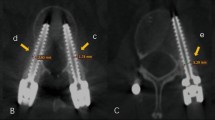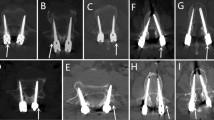Abstract
Background
The accuracy of robot-assisted pedicle screw implantation is a safe and effective method in lumbar surgery, but it still remains controversial in lumbar revision surgery. This study evaluated the clinical safety and accuracy of robot-assisted versus freehand pedicle screw implantation in lumbar revision surgery.
Methods
This was a retrospective study. From January 2018 to December 2019, 81 patients underwent posterior lumbar revision surgery in our hospital. Among them, 39 patients underwent revision surgery performed with robot-assisted pedicle screw implantation (Renaissance robotic system), whereas the remaining 42 patients underwent traditional freehand pedicle screw implantation. All patients underwent magnetic resonance imaging (MRI), computed tomography (CT), and X-ray before revision surgery. The sex, age, body mass index, bone mineral density, operative time, blood loss, operative segments, intra-operative fluoroscopy time, and complications were compared between the two groups. The accuracy of pedicle screw implantation was measured on CT scans based on Gertzbein Robbins grading, and the invasion of superior level facet joint was evaluated by Babu’s method.
Results
There was no statistical difference about the baseline between the two groups (P > 0.05). Although there were no significant differences in operative time and complications between the two groups (P > 0.05), the robot-assisted group had significantly less intra-operative blood loss and shorter intra-operative fluoroscopy times than the freehand group (P < 0.05). In the robot-assisted group, a total of 267 screws were inserted, which were marked as grade A in 250, grade B in 13, grade C in four, and no grade D or E in any screw. In terms of invasion of superior level facet joint, a total of 78 screws were inserted in the robot-assisted group, which were marked as grade 0 in 73, grade 1 in four, grade 2 in one, and grade 3 in zero. By comparison, 288 screws were placed in total in the freehand group, which were rated as grade A in 251, grade B in 28, grade C in eight, grade D in one, and no grade E in any screw. A total of 82 superior level facet joint screws were inserted in freehand group, which were marked as grade 0 in 62, grade one in 18, grade 2 in two, and grade 3 in zero. The robot-assisted technique was statistically superior to the freehand method in the accuracy of screw placement (P < 0.05).
Conclusion
Compared with freehand screw implantation, in lumbar revision surgery, the Renaissance robot had higher accuracy and safety of pedicle screw implantation, fewer superior level facet joint violations, and less intra-operative blood loss and intra-operative fluoroscopy time.




Similar content being viewed by others
References
Wu M-H, Dubey NK, Li Y-Y, Lee C-Y, Cheng C-C, Shi C-S, Huang T-J (2017) Comparison of minimally invasive spine surgery using intraoperative computed tomography integrated navigation, fluoroscopy, and conventional open surgery for lumbar spondylolisthesis: a prospective registry-based cohort study. Spine J 17:1082–1090. https://doi.org/10.1016/j.spinee.2017.04.002
Gao S, Lv Z, Fang H (2018) Robot-assisted and conventional freehand pedicle screw placement: a systematic review and meta-analysis of randomized controlled trials. Eur Spine J 27:921–930. https://doi.org/10.1007/s00586-017-5333-y
Han X, Tian W, Liu Y, Liu B, He D, Sun Y, Han X, Fan M, Zhao J, Xu Y, Zhang Q (2019) Safety and accuracy of robot-assisted versus fluoroscopy-assisted pedicle screw insertion in thoracolumbar spinal surgery: a prospective randomized controlled trial. J Neurosurg Spine:1–8. https://doi.org/10.3171/2018.10.SPINE18487
Schröder ML, Staartjes VE (2017) Revisions for screw malposition and clinical outcomes after robot-guided lumbar fusion for spondylolisthesis. Neurosurg Focus 42:E12–E12. https://doi.org/10.3171/2017.3.FOCUS16534
Molliqaj G, Schatlo B, Alaid A, Solomiichuk V, Rohde V, Schaller K, Tessitore E (2017) Accuracy of robot-guided versus freehand fluoroscopy-assisted pedicle screw insertion in thoracolumbar spinal surgery. Neurosurg Focus 42:E14–E14. https://doi.org/10.3171/2017.3.FOCUS179
Hyun S-J, Kim K-J, Jahng T-A, Kim H-J (2017) Minimally invasive robotic versus open fluoroscopic-guided spinal instrumented fusions: a randomized controlled trial. Spine 42:353–358. https://doi.org/10.1097/BRS.0000000000001778
Zhang JN, Fan Y, Hao DJ (2019) Risk factors for robot-assisted spinal pedicle screw malposition. Sci Rep 9:3025–3025. https://doi.org/10.1038/s41598-019-40057-z
Gertzbein SD, Robbins SE (1990) Accuracy of pedicular screw placement in vivo. Spine 15:11–14
Babu R, Mehta AI, Brown CR, Isaacs RE, Bagley CA, Gottfried ON (2012) Comparison of superior level facet joint violations during open and percutaneous pedicle screw placement. Neurosurgery 12(9):S47–S47
Devito DP, Kaplan L, Dietl R, Pfeiffer M, Horne D, Silberstein B, Hardenbrook M, Kiriyanthan G, Barzilay Y, Bruskin A, Sackerer D, Alexandrovsky V, Stüer C, Burger R, Maeurer J, Donald GD, Schoenmayr R, Friedlander A, Knoller N, Schmieder K, Pechlivanis I, Kim I-S, Meyer B, Shoham M (2010) Clinical acceptance and accuracy assessment of spinal implants guided with SpineAssist surgical robot: retrospective study. Spine 35:2109–2115. https://doi.org/10.1097/BRS.0b013e3181d323ab
Keric N, Eum DJ, Afghanyar F, Rachwal-Czyzewicz I, Renovanz M, Conrad J, Wesp DMA, Kantelhardt SR, Giese A (2017) Evaluation of surgical strategy of conventional vs. percutaneous robot-assisted spinal trans-pedicular instrumentation in spondylodiscitis. J Robot Surg 11:17–25. https://doi.org/10.1007/s11701-016-0597-5
Hu X, Lieberman IH (2014) What is the learning curve for robotic-assisted pedicle screw placement in spine surgery? Clin Orthop Relat Res 472:1839–1844. https://doi.org/10.1007/s11999-013-3291-1
Lee CS, Hwang CJ, Lee S-W, Ahn Y-J, Kim Y-T, Lee D-H, Lee MY (2009) Risk factors for adjacent segment disease after lumbar fusion. Eur Spine J 18:1637–1643. https://doi.org/10.1007/s00586-009-1060-3
Levin JM, Alentado VJ, Healy AT, Steinmetz MP, Benzel EC, Mroz TE (2018) Superior segment facet joint violation during instrumented lumbar fusion is associated with higher reoperation rates and diminished improvement in quality of life. Clin Spine Surg 31:E36–E41. https://doi.org/10.1097/BSD.0000000000000566
Yson SC, Sembrano JN, Sanders PC, Santos ERG, Ledonio CGT, Polly DW Jr (2013) Comparison of cranial facet joint violation rates between open and percutaneous pedicle screw placement using intraoperative 3-D CT (O-arm) computer navigation. Spine 38:E251–E258. https://doi.org/10.1097/BRS.0b013e31827ecbf1
Teles AR, Paci M, Gutman G, Abduljabbar FH, Ouellet JA, Weber MH, Golan JD (2018) Anatomical and technical factors associated with superior facet joint violation in lumbar fusion. J Neurosurg Spine 28:173–180. https://doi.org/10.3171/2017.6.SPINE17130
Kim H-J, Jung W-I, Chang B-S, Lee C-K, Kang K-T, Yeom JS (2017) A prospective, randomized, controlled trial of robot-assisted vs freehand pedicle screw fixation in spine surgery. Int J Med Robot 13(3). https://doi.org/10.1002/rcs.1779
Khan MH, Rihn J, Steele G, Davis R, Lee JY (2006) Postoperative management protocol for incidental dural tears during degenerative lumbar spine surgery: a review of 3,183 consecutive degenerative lumbar cases. Spine 31:2609–2613
Yoshihara H, Chatterjee D, Paulino CB, Errico TJ (2016) Revision surgery for “real” recurrent lumbar disk herniation: a systematic review. Clin Spine Surg 29:111–118. https://doi.org/10.1097/BSD.0000000000000365
Tormenti MJ, Maserati MB, Bonfield CM, Gerszten PC, Moossy JJ, Kanter AS, Spiro RM, Okonkwo DO (2012) Perioperative surgical complications of transforaminal lumbar interbody fusion: a single-center experience. Journal of neurosurgery Spine 16:44–50. https://doi.org/10.3171/2011.9.SPINE11373
Tian W, Han X, Liu B, Liu Y, Hu Y, Han X, Xu Y, Fan M, Jin H (2014) A robot-assisted surgical system using a force-image control method for pedicle screw insertion. PLoS One 9:e86346–e86346. https://doi.org/10.1371/journal.pone.0086346
Roser F, Tatagiba M, Maier G (2013) Spinal robotics: current applications and future perspectives. Neurosurgery 72(Suppl 1):12–18. https://doi.org/10.1227/NEU.0b013e318270d02c
Author information
Authors and Affiliations
Corresponding author
Ethics declarations
Conflict of interest
The authors declare that they have no conflict of interest.
Ethical approval
This article does not contain any studies with human participants or animals performed by any of the authors.
Informed consent
Informed consent was obtained from all individual participants included in the study (optional).
Additional information
Publisher’s note
Springer Nature remains neutral with regard to jurisdictional claims in published maps and institutional affiliations.
Electronic supplementary material
ESM 1
(XLSX 44 kb)
Rights and permissions
About this article
Cite this article
Zhang, JN., Fan, Y., He, X. et al. Comparison of robot-assisted and freehand pedicle screw placement for lumbar revision surgery. International Orthopaedics (SICOT) 45, 1531–1538 (2021). https://doi.org/10.1007/s00264-020-04825-1
Received:
Accepted:
Published:
Issue Date:
DOI: https://doi.org/10.1007/s00264-020-04825-1




